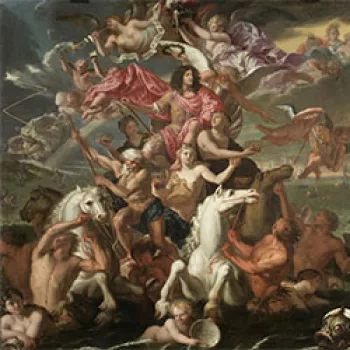James II 1685
Engraving with etching | 55.0 x 39.3 cm (sheet of paper) | RCIN 602839
-
An engraving with etching of James II as king. Bust length portrait with a wig, a lace cravat, armour and a sash over his left shoulder. With a coat of arms and a Latin inscription below. First state; for the second state see RCIN 602940. The print is dedicated to Philip Thomas Howard (1616–94), Cardinal Norfolk, then resident in Rome. The accession of the openly Catholic James II in 1685 gave great hope to the Roman Church that Catholicism would be restored as the state religion in England, and this print was issued in Rome that same year.
This print lettered around the portrait: "IACOBVS SECVNDVS REX ANGLIÆ. &c. DEFENSOR FIDEI."; at the lower centre:" ,Em:mo et Reu:mo Principi, Philippo Thome Howardo. S.R.E … / Sacra Deo reddit; strauit per Regna rebelles. / Regni sui Anno. p.o // Incidit et excudit Arnoldus Van Westerhaut Antuerp Rome cum licen: Super An: 1685".
This virtuoso etching was produced in Rome by Dutch printmaker Arnold van Westerhout, and depicts James II as the newly crowned king. It embodies the hopes of the Roman Church that the faith would soon be restored to Britain. The print is dedicated to another prominent English Catholic, Philip Howard, Cardinal Norfolk, who took up residence in Rome in 1675, where he vigorously promoted the Anglo-Catholic cause. During the interregnum, James II spent much of his time in France and Spain, strengthening his links to Catholicism. Charles II had attempted to temper the Catholic influence of James II, by arranging for his daughters Mary and Anne to marry into Protestant houses of the Netherlands and Denmark. James II's openly Catholic sympathies would lead to his removal from power and the ascension of his protestant daughter and son-in-law.
Text adapted from Charles II: Art & Power, London, 2017
The print formed part of an album of British royal portrait prints assembled by Cassiano and his younger brother Carlo Antonio dal Pozzo in Rome. Described in an early nineteenth-century inventory of prints in George III's library as Kings of England and their Families from Henry VII to James II, the album was arranged chronologically, with kings and their consorts together. It was dismantled later in the nineteenth century and its prints incorporated into the series of Engraved Royal Portraits (organised dynastically).
For more information see Mark McDonald, The Print Collection of Cassiano dal Pozzo. I: Ceremonies, Costumes, Portraits and Genre, 3 vols, Royal Collection Trust 2017, part of The Paper Museum of Cassiano dal Pozzo: A Catalogue Raisonné, cat. no. 1407.Provenance
From the collection of Cassiano dal Pozzo (1588-22 October 1657); inherited by his brother, Carlo Antonio dal Pozzo (1606-1689); sold by Carlo Antonio's grandson to Clement XI, 1703; acquired by Cardinal Alessandro Albani by 1714, from whom the collection was purchased by George III in 1762
-
Creator(s)
(collector)Acquirer(s)
-
Medium and techniques
Engraving with etching
Measurements
55.0 x 39.3 cm (sheet of paper)
54.0 x 38.4 cm (image)
Category
Object type(s)
Alternative title(s)
IACOBVS SECVNDVS REX ANGLIAE & DEFENSOR FIDEI










